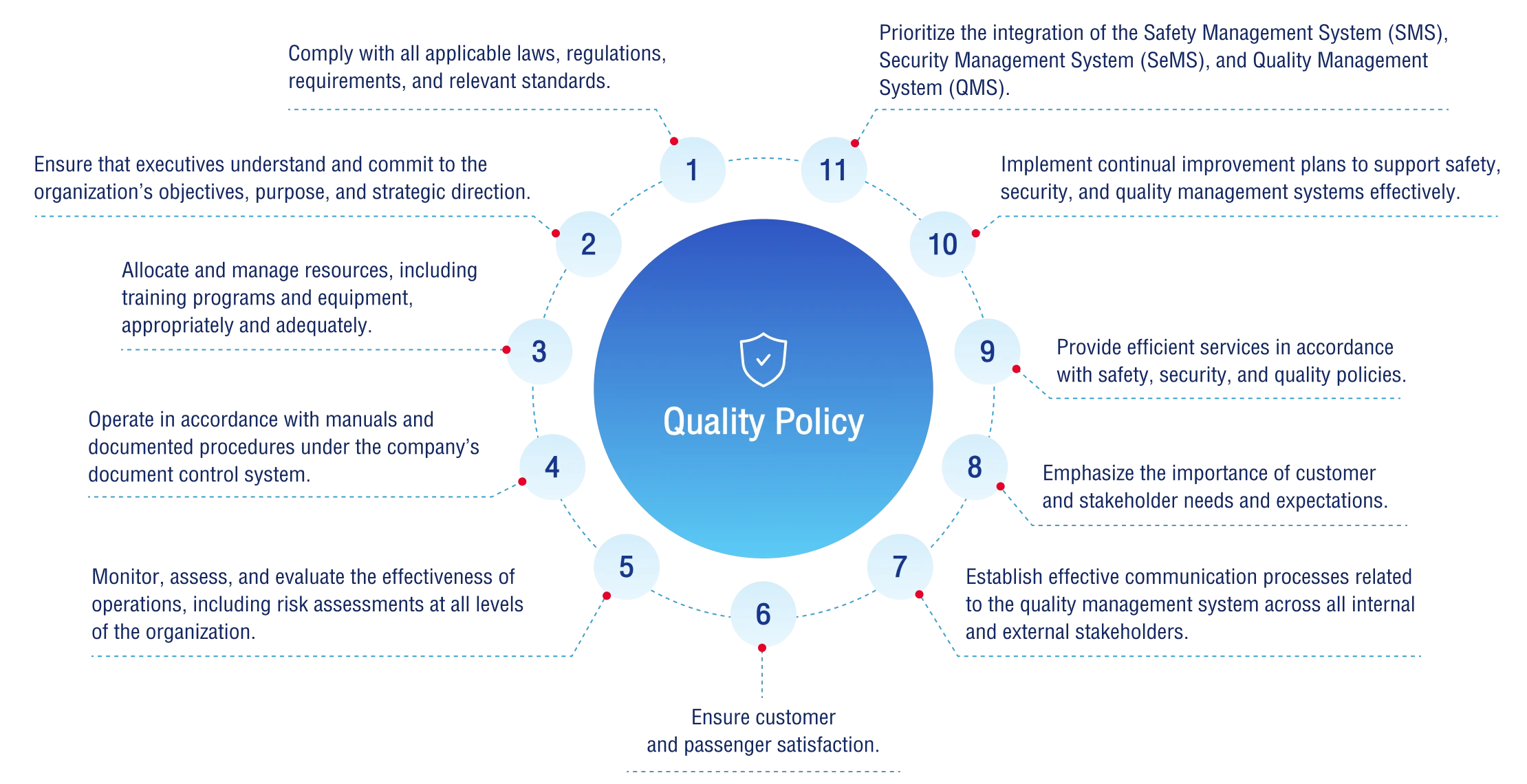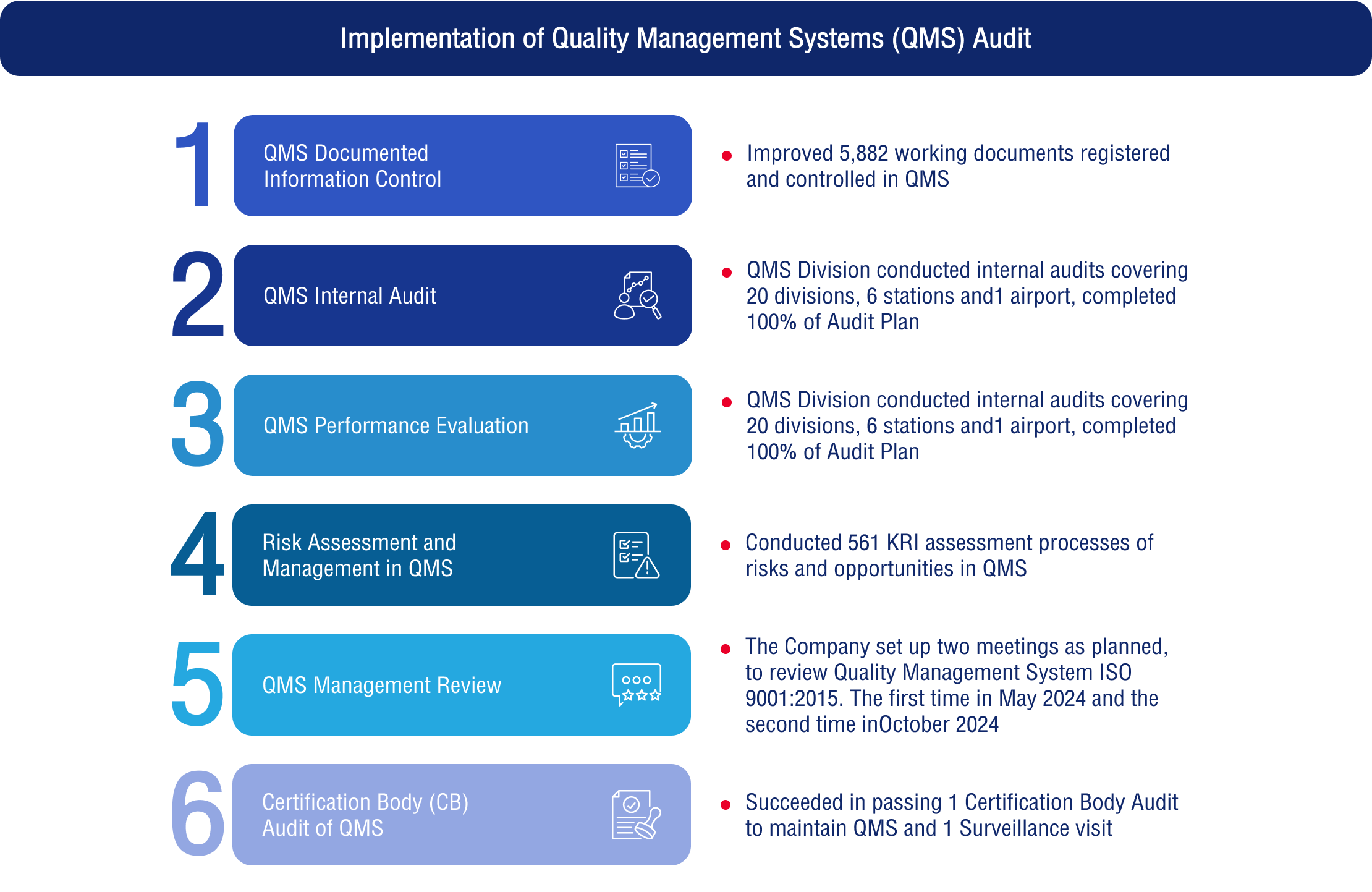

Governance Performance
Commitment / management guideline
Create sustainable economic growth together
The Company upholds and complies with the principles of good corporate governance in operating the Company’s business by the directors, management, and employees; and considers that the principles of good corporate governance are an essential factor to support the overall achievement of the Company as the organization responsible for the society. The Company’s policies on corporate governance will comply with the guideline on good corporate governance in accordance with the Principles of Good Corporate Governance for Listed Companies, 2012 set by the Stock Exchange of Thailand.
Corporate Governance and Anti-Corruption
Target

Management Guideline
The Company is committed to conducting its business in accordance with the principles of good corporate governance, upholding transparency, accountability, fairness, and consideration for all stakeholders. This is achieved through the promotion of an ethical and honest corporate culture, the establishment of secure and independent whistleblowing and complaint channels, as well as the continuous development of employee knowledge. These efforts aim to build an effective internal control system, reduce the risk of corruption, and strengthen the confidence of shareholders, investors, and society at large in the Company’s commitment to sustainable business practices in alignment with international standards.
Implementation
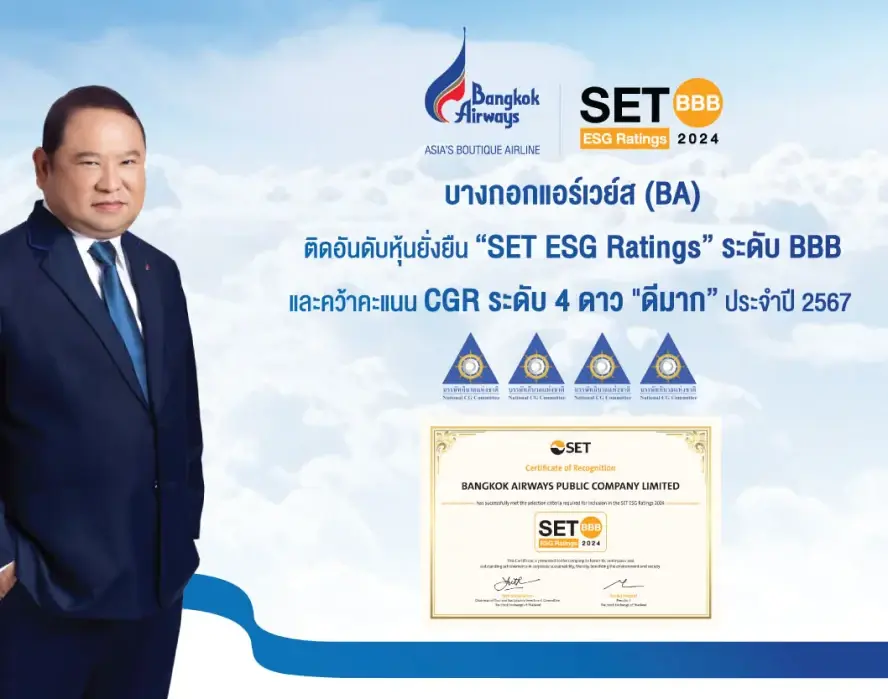
Bangkok Airways was selected as one of the listed companies that achieved a “Very Good” Corporate Governance score, as a result of a survey conducted by the Thai Institute of Directors with the support of the Stock Exchange of Thailand. Started in 2023 and continued in 2024, the Company conducted a survey of all employees on their understanding of the Code of Business Conduct, with the objective to support and promote responsible performance of duties and compliance with both corporate good governance principles and the organization’s sustainability policy.
Risk Management
Target

Management Guideline
Corporate Risk Management Committee screened policy and supervisory guideline of risk management, monitored result of management according to risk mitigation plan of all departments. Risk Management Division to report result of quarterly review of risk management to Corporate Risk Management Committee regularly to make sure that the Company can mitigate opportunities and impact of risks, particularly critical and emerging risks at an acceptable level (alige with risk appetite).

Risk Management Structure
Corporate Risk Management Committee screened policy and supervisory guideline of risk management, monitored result of management according to risk mitigation plan of all departments. Risk Management Division to report result of quarterly review of risk management to Corporate Risk Management Committee regularly to make sure that the Company can mitigate opportunities and impact of risks, particularly critical and emerging risks at an acceptable level (align with risk appetite).

Risk Management Culture
Executives and employees at all levels are responsible for putting risk management framework and policy into practice and be aware of risks involved in operations, both in own department and the organization, provided measures or sufficient control to reduce level of risks, used Key Risk Indicators (KRI) to assist in monitoring and managing risks, with regular review and improvement, in line with the situation and strategy of the organization. In addition, employees received training on understanding of risks and are able to perform duties efficiently.
Implementation

Business Risk Factors
Explore More
Emerging Risk
Climate Risk
Risk Management Guideline
- Implementation of Fuel Efficiency Program
The Company has studied various approaches to improve operational efficiency, ensuring that each flight uses aviation fuel effectively and reduces carbon dioxide emissions. In addition, the Company has undertaken multiple initiatives to minimize carbon emissions during flight operations as much as possible. These include flight planning and operations using modern air navigation technology, scheduled engine cleaning, and analysis of operational data to enhance flight efficiency and reduce carbon dioxide emissions. The Company has also explored the application of Artificial Intelligence (AI) and Machine Learning technologies to increase the accuracy and efficiency of data analysis, in compliance with regulations and requirements for the highest level of flight safety. - Study and Preparation for the Use of Sustainable Aviation Fuel (SAF)
Thailand is expected to begin using Sustainable Aviation Fuel at a proportion of 1% by 2026. The Company is currently in the process of preparing to implement this initiative in accordance with international sustainability cooperation measures and policies.
Geopolitical Risk
Risk Management Guideline
Understanding geopolitical risks and closely monitoring relevant news to ensure preparedness and identify mitigation measures. This includes monitoring key economic indicators such as inflation rates and exchange rates to support flight planning and explore new business opportunities, as well as keeping track of government policies related to tourism.
Technology Change Risk
Risk Management Guideline
Understanding and evaluating the appropriate adoption of Artificial Intelligence (AI) for the Company, along with conducting feasibility studies to explore opportunities for business development.

Strengthening Risk Management Culture
Providing training and disseminating knowledge about risk and risk management to personnel
- Educate new employees through the orientation program, including a topic on basic knowledge of risk management.
- Conduct training sessions and share knowledge on various types of risks via the Company’s intranet system to ensure that employees understand and are aware of risks and their management. Topics include cyber threat risks, information technology security awareness, operational safety, and aviation security knowledge.
Promoting Employee Awareness of Work-Related Risk Management
- Require all departments to review risk assessments at both departmental and organizational levels in collaboration with the designated risk owners. The objective is to identify potential risks arising from internal and external factors and to define appropriate risk management measures. This includes preparing risk assessment documents such as RMD (Risk Management by Department) and RMC (Corporate Risk Management), and monitoring high-level risk mitigation measures to ensure they are reduced and maintained at an acceptable level.
- Conduct simulation exercises to help employees understand and recognize the importance of managing safety-related risks, including occupational health, workplace environmental safety, and aviation safety.
Quality Products and Services
Target

Management Guideline
The Company has every intention to comply with safety standards, to perform flights punctually, and to achieve customer satisfaction with an awareness of quality, flight safety, flight security, and continuous development/improvement. These elements are crucial to realizing the objectives of the Company. All activities and necessary resources are managed under the corporate quality management system to ensure that the Company can continuously support and drive the efficiency and effectiveness of its products and services to meet stakeholders’ needs and expectations.
QMS Core Control
The Quality Management Division is responsible for setting strategies, planning, supervising, administering, controlling, and developing the Quality Management Systems of all divisions in the Company, including contractors, to comply with the requirements of the ISO 9001 Quality Management System Standard and the Company’s Quality Management System Standard, in alignment with applicable laws and related performance standards.
Implementation
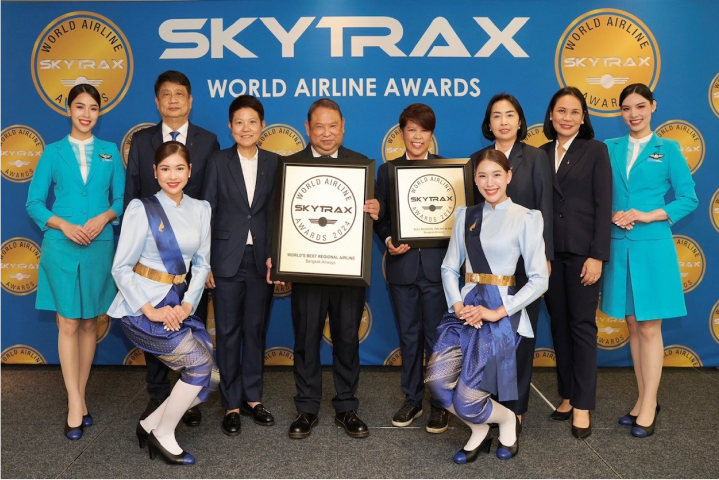
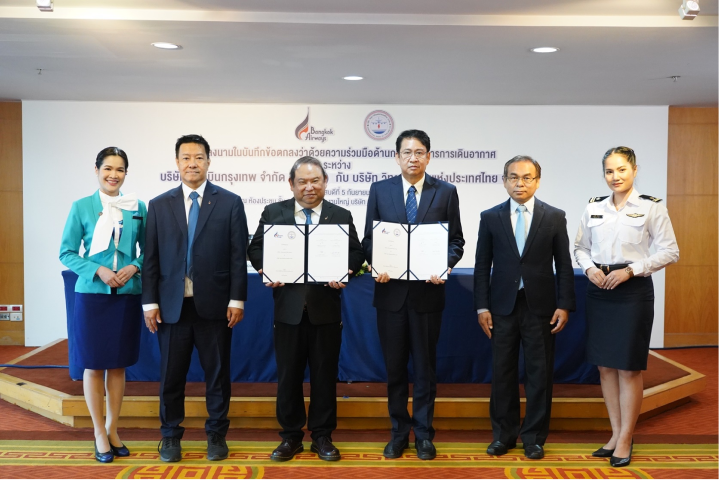
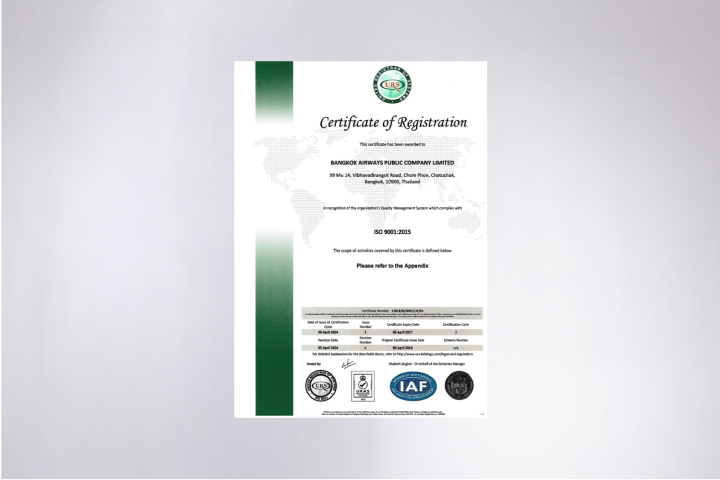
Sustainable Supply Chain Management
Target 2024

Management Guideline
The Company has a commitment to operate sustainable business growth and create long-term value for suppliers at the same time, by focusing on sustainable management of supply chains, promote confidence for stakeholders, lower risks, increase opportunities, and upgrade competitiveness of business without lowering international safety standards, with readiness to provide continuous services to passengers.
Implementation

-
1Announced Sustainable Procurement Policy and Supplier Code of Business Conduct.
Supplier Code of Business Conduct
To strengthen sustainable supply chains and support anti-corruption and transparency, the Company started to implement the Supplier Code of Business Conduct (SCOC) by assessing suppliers’ qualifications to ensure that products and services are sourced in an ethical and sustainable manner. In this regard, key suppliers of the Company are required to strictly comply with the SCOC. Consistent with the ESG mission, suppliers should also consider their responsibilities toward society and the environment.
Supplier Assessment, Selection and Monitoring
Suppliers are assessed by the Company and selected according to the ability to comply with stated requirements, including quality, quantity, price, delivery choices, capability, and willingness to alleviate problems that may arise related to products or services. Additionally, suppliers are required to set policy on employment of foreign labour that is strictly aligned with human rights policy and labour laws. After the policy is approved, suppliers are to sign the SCOC to complete the process. The approved suppliers will be subjected to annual assessment, e.g. product quality, efficient delivery, after-sales services, social and environmental participation.
Sustainable Procurement
To pursue circular economy and lower carbon emissions, the Company has been using recycled paper sourced from trees grown in sustainable agricultural land to support conservation of natural forests, as well as using FSC-certified towels and tissues made from 100% recycled yarn. The Company also considered sourcing food items locally to promote and support community self-reliance, such as low-carbon coffee served in the Business Class Passenger Lounge. Other non-food items are also purchased locally as far as possible to reduce carbon emissions from inter-province or international transport.

-
2The Company shall conduct a sustainable risk assessment of key suppliers which is expected to be completed in 2025.
Customers Experience Management
Target

Management Guideline
The Company manages customer experience with a focus on utilizing automation systems. This includes conducting customer satisfaction surveys using the Bizcuit system, which allows for the analysis of both quantitative results and open-ended feedback. Additionally, the Company co-developed the T-DNA system to store and retrieve customer profiles and travel history, which can be further leveraged to enhance travel experience management for individual customers or customer segments with similar characteristics. Also to work jointly with Customer Experience Management Section and supervisors at service touch points in order to mitigate or systematically prevent recurring events with the goal to measure effectiveness of corrective or preventive processes according to Plan-Do-Check-Act (PDCA) principle.
Implementation
Customer Satisfaction Survey
-
1Website
-
2Call Center
-
3Ticketing
-
4Check-in
-
5Passenger lounge / Courtesy corner
-
6Passenger boarding service & facilities
-
7Cockpit Crew announcement
-
8Cabin Crew
-
9Food & Beverage served on board (or snack bag during disembarking the aircraft)
-
10Aircraft Cabin & Seat
-
11Aircraft Cabin Cleanliness
-
12Staff & Service at Arrival
-
13Baggage Service & Claim at Arrival
-
14Flight Punctuality
-
15Flight Safety
Remark Frequency: 2 times per year (survey conducted in January 2024 and July 2024)
Result of Customer Satisfaction Survey 2024
Business Innovation and Value Creation
Target 2024

Management Guideline
The Company has a policy to support employee concept to develop operation process thatcreate value for the organization e.g.
reduce costs, lower negative impact, increase income or create new innovation for the society or the environment in response to needs of stakeholders, promote potential development of emplouees and create competitive edge for the organization.
Implementation

“Arranged a training course on Innovation in Business and Value Creation.”
To develop competency, knowledge, skills, and potential for executives and employees, consistent with key sustainable issues of the organization, taking into account impact on environment - social - governance (ESG) in relation to innovation in business and value creation, promoting steady growth with responsibilities towards stakeholders throughout the value chain.
Participants received basic knowledge on innovation in business and value creation through examples on innovation in the aviation industry and were encouraged to develop creative ideas, use the Innovation Service Package to deliver happiness to passengers by providing impressive services in accordance with the sustainable commitment to “Connect Your Happiness”.
The 79 employees who attended the course were evaluated and gained “very good” result or 91%.

Example on innovation development in operation by Customer Care team for convenience of passengers
-
Starting to use: 10 July 2024
Developed system to accept cash payment for tickets and other services whereby customer to scan QR code using Mobile Applications of any bank. This system increases channel for payment, provides more opportunities to sell tickets with the ability to support payment for other sales promotions e.g. payment for membership or renewal of membership, for privileged card etc. The new system can reduce errors in filling payment code and prevent payment to wrong account number.Quantitative Business Benefit
After starting to use this system, the Company received excellent customer feedback. Payments made via QR Code generated total revenue of 45 million Baht in 2024.Quantitative Benefit to Society and the Environment
Customers experienced greater convenience in using the service, with a total of over 13,000 transactions recorded in 2024. - Developed Online Receipt system to enhance issuance of receipt when purchasing extra services, formerly can only issue receipt for ticket payment. Customers can issue receipt by themselves quickly via the airline website. Electronic receipt added customer convenience because there is no need to print out as in the past.
- Improved Call Center Telephone System from On Premises to Hosted Solution Private Cloud to accommodate feature related to management of relationship with customers and future system development. The new features consisting detailed history of customer contact enable the Company to share information with employees, helping them to analyse and repond to cusomters’ needs quickly with possibility to create more impressive services.
Cyber Security
Target

Management Guideline
In the past 2-3 years, the Company complied with Computer Crime Act B.E. 2560 and Cyber Security Act B.E. 2560, using as guideline to supervise internal performance, ensuring continuous safety and security of operating system, resulting in making Information Systems the key mechanism to sustainably drive and manage operation of the business.
Due to the current state of cyber threats, the Civil Aviation Authority of Thailand, as the regulatory body for air transport in the transport and logistics sector under the Cybersecurity Act B.E. 2562 (2019), issued an order appointing the Company as a Critical Information Infrastructure (CII) organization in 2024. This designation places significant responsibilities on the Company to support Thailand’s readiness and cybersecurity in the aviation sector. In addition to the obligation to comply with various regulations under the Cybersecurity Act, the Company is regularly monitored and audited for standards compliance by both the National Cyber Security Committee (NCSC) and the Civil Aviation Authority of Thailand. Moreover, this presents an opportunity for the Company to adopt and apply Thailand’s national cybersecurity standards framework to enhance and improve its own internal cybersecurity procedures in the future.
Implementation
The Company continues to operate based on Cybersecurity Management and Information Security Management frameworks. In 2024, the Company demonstrated clear improvements in its performance compared to the previous year. The summary is as follows:

Threat identification
As the Company is able to access threat intelligence from internationally acceptable sources, it is possible to check whether or not such an incident is a form of threat. The detection result made it possible to manage the threat incident in a timely manner. There is also a basic system to detect software with cybersecurity vulnerabilities or endpoint risks, helping IT responsible persons to limit and prioritize software management on such endpoints efficiently. After detection of endpoint software vulnerabilities, the Company began to check vulnerabilities and conduct penetration testing of operating systems currently in service, leading to the definition of standards and cybersecurity processes for overall operating systems at present and in the future.

Threat Protection
The Company set policy with clear direction that basic prevention of cyber threats starts from employees who are well aware and understand current threats. The Company consistently promotes cyber security awareness for executives and employees at all levels, presented in many forms and situations so personnel would be familiar with all kinds of threats and ever changing tactics of attack, through Knowledge Management for executives and employees in general and those involved in cyber security incidents so they would improve working methods to be in line with proper practices and standards. Understanding, familiarizing and recognizing constantly changing threat scenario by all employees is the key to effectively mitigate risks of cyber threat. Employees were evaluated on understanding of cyber threats and gained result at satisfactory level.

Recovery after being threatened
Regarding work in system restoration, the Company provided readiness of data backup, so data would be readily available if required to recover data and operating system, and stipulated work process according to quality standard ISO 9001. Checking back up and recovery of data and operating systems is conducted consistently to make sure the Company is well prepared if required to recover operating system and data after cyber threats. The recovery system is reviewed and certified by IATA Operational Safety Audit (IOSA) and the result achieved the standard at satisfactory level.
